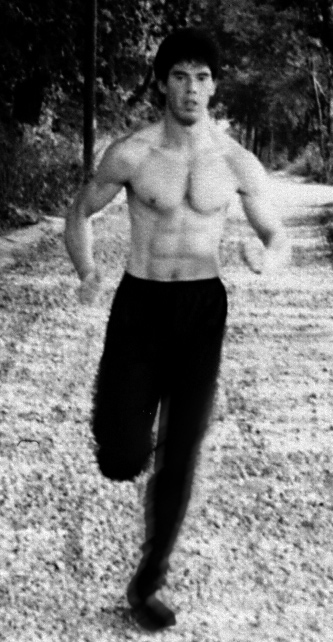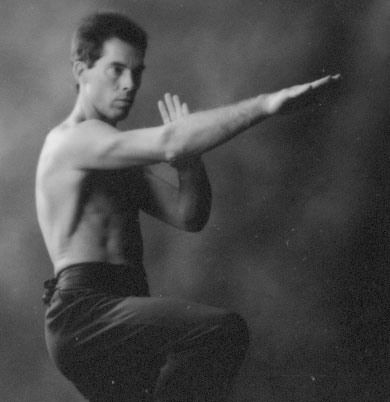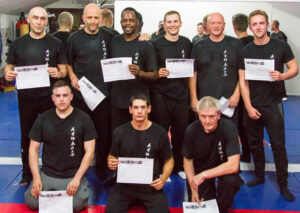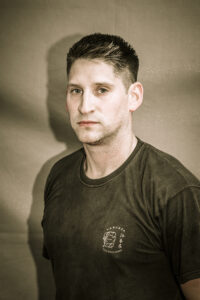Martial Arts Illustrated
M.A.I.’s Bob Sykes talks to Wing Chun master James Sinclair about Wing Chun principles, skill acquisition, shoot range fighting and just why he feels its important to constantly question his students.
Bob Sykes: OK, James, could you start by telling us how you became involved in the martial arts?

James Sinclair: I became involved in martial arts in 1972 when I took up a style of karate. My enthusiasm for martial art grew from there. Being young and impressionable my karate instructor accepted his responsibility fully and sowed the seeds that have lead me to martial art as a profession. I did not stay with karate but I hope he would be proud. Thanks go out to Sensei Alan White. However, In 1975 I saw an advertisement for Wing Chun Kung Fu and I have trained in this one style ever since.
Bob Sykes: What was it that initially attracted you to Wing Chun?
James Sinclair: I chose Wing Chun because Bruce Lee was in the media. I was young and I’d heard of this man, Bruce Lee, and that he did Wing Chun. So when I saw an advertisement for Wing Chun I jumped at the chance.
Bob Sykes: I’ve heard many people say that Wing Chun wouldn’t be nearly as popular and famous today if Bruce Lee hadn’t done it. Do you think that that kind of exposure has been at all beneficial to the overall development of Wing Chun?
James Sinclair: Bruce Lee certainly benefited the exposure of Wing Chun and martial art in general. Karate, Judo and Taekwondo have benefited the most because of a lack of Wing Chun teachers being available. Without any doubt Wing Chun wouldn’t have been as popular a system if it weren’t for Bruce Lee’s name. Wing Chun was only a very small system in mainland China and as far as I know not practised in Hong Kong until Ip man went there.
To my mind Bruce Lee did great justice to the style, but since then there have been a lot of problems. A lot of people jumped on the bandwagon by saying that they had done Wing Chun. Also the television series Kung Fu was screening at about the same time. To this day much of the public don’t realise that there are many different styles of kung fu and karate, they are only familiar with the generic term’s karate and kung fu.
As for Wing Chun’s development, I feel the style has great potential, but it is stifled by people who want control, and use the term ‘traditional’ or ‘classical’ martial art. Wing Chun is a relatively young style, and was radically different to the Sui Lam styles of the era. It continued to evolve generation after generation. But now Wing Chun seems to have stopped growing with the death of Grandmaster Ip Man and all the public fighting for control of the style.
After 1989, when China really began to open up, people realised Ip Man was not alone in studying Wing Chun and that he continued the evolution and change within the style. Instead of embracing his input some people are looking for a ‘pure’ Wing Chun, which has probably never existed. If we could find out how Wing Chun was 200 years ago, we would see a pretty undeveloped art, compared to the progress made from those initial theories. I understand the security afforded by history and a sense of family and identity, but why people want to go back in time and do something that was less refined than that available now can only be compared to classic car enthusiasts. The theories and principles of Wing Chun are the essence of the style, if you lose the essence then you will have a different product.
Basically Wing Chun should develop and change, evolution is a positive force for growth. Tradition has a very important role in martial art and is significant in the history and identity of all the great systems, but development is always possible on top of this.
Other stylists are happy to take the theories and even specific techniques that Wing Chun has originated and developed in order to improve their own training. However, these stylists could lose the essence of their style and if this happens they should no longer call the style by its traditional name. They should have the courage to market a new product. Master Derek Jones had that courage and it was admirable. Wing Chun is an amazing system, and like most things in life, has it’s contradictions, but overall it is a ‘great little style’, I believe someone else more significant than me said that. (Bruce Lee). I feel it is ironic that no matter how many Wing Chun teachers say how different they are, it is the inherent similarities that are most obvious. Wing Chun will not be lost with growth and improvements in training approach.

Bob Sykes: Do you have a training schedule, if so what does it consist of?
James Sinclair: My training schedule has varied over the years. Not unlike many people when I was younger I over-trained. I had far more enthusiasm than experience, and I trained excessively. These days I’ve come to realise the importance of a training schedule based on progressive training and recuperation.
Bob Sykes: So what’s in a weeks training for James Sinclair?
James Sinclair: I train most days and three times a week in the gym. I work on martial art training, the punching, the conditioning and the forms. I also train with Sifu Mark Phillips twice a week where we do a lot of sparring, sticky hands and skill acquisition work. You can’t maintain peak form forever. If a challenging situation arose I could get into far better shape within six weeks than I’d been for quite some time, but to push for the rest of your life like that, with no clear goal, would simply burn a person out. What I do is build my base level. This means that even at my worst my basic skill is going to be way beyond what it was, say a year ago. Murphy’s Law, always states that you will be confronted when you feel at your lowest as you look like a victim to a depraved mind. Therefore, I’m not rushing like a mad bull at a gate, instead I am analysing my training carefully, sensibly and progressively. Basically, my training schedule consists of fitness training, but that’s a personal thing, also skill acquisition, drills, routine training, pattern training, trying to recognise shapes and recognise frames, and recognising where I am relative to my opponent when under extreme pressure, in order to come out with that ‘lucky’ strike. I have had thousands of sparring sessions that are very hard, where I take on one opponent after another for over an hour non-stop, each one fresh and pushing me, and whilst they are valuable they are way beyond what is needed for self defence against Joe Bloggs. But not every single training session I do is a pressure session, some of them are quite steady, quite simple, at an analysing pace, geared toward both sides learning.

My personal training is just that, personal. My responsibility and skills are really in communication, the skill of teaching, motivation and coaching. I concentrate on the coaching of my students. It has taken me years to develop a teaching programme and instructor training syllabus that gets the results I am happy with.
Bob Sykes: Do you feel, James, that it’s important to have a good and regular training partner to both drill and grow with?
James Sinclair: It’s essential. In Wing Chun we have a wooden dummy to work on but its not alive, you need a person who knows your weaknesses, who can take advantage of your weaknesses, who’s only too willing to point out those weaknesses. The hard part is finding those skilful partners. It is a case of coaching them and and that they have the right aptitude and fortitude to work. I then pass the experience onto my students, in order that my students don’t start where I started. They start a rung higher than I did because I’m teaching from my own experience.
Bob Sykes: Would you say that you give all your students the straight gen and hold nothing back?
James Sinclair: Absolutely, one hundred percent. I’m not there to teach for myself, I’m there to teach for other people. I teach and its my living, I’m quite open about that. I consider that my job is to inspire people with Wing Chun and I have taught many, many of the country’s most recognised Wing Chun instructors. People often accuse me of going on a lot, I gas a lot or I talk too much, but at the end of the day I’m constantly asking my students questions. Most people think that the students ask the instructors questions, they do, but I also question them because I’m trying to teach them how to think as a Wing Chun practitioner. When they find themselves alone and under pressure or in an environment or a situation that they’ve never previously dealt with, they have to try and think as a Wing Chun practitioner, because they can then adapt themselves to the situation. Wing Chun a way of thinking as well as moving.
It is makes no sense to teach hundreds of different techniques for hundreds of different situations. Instead, you need a few ideas or simple principles that you can use and adapt rather than a multitude of techniques. As I said a way of thinking. You need flexible ideas because principles of technique are far more important than the strict shape and technique.
Shape defines a style. When we look at a karateka we can see by the way he stands, the way he throws his punch, the way that he moves, that he’s doing karate. Many Wing Chun teachers have commented on how well I manage to get students to move and fight fluently, and yet remain so easily recognised as Wing Chun practitioners. It seems that many people in Wing Chun train in the Wing Chun forms, they do wooden dummy, the knives, the pole and sticky hands, but when they come to spar or fight they don’t try to use the style. Instead they put on gloves. Wing Chun is a not a style that you can realistically practice with boxing gloves on.
Bob Sykes: My good friend Lance Lewis once described Wing Chun as boxing without gloves, would you agree with his point?

James Sinclair: I’d say it’s got elements of boxing. There’s no doubt that Wing Chun is primarily a hand-orientated style because when you are close range you’re not really going to lift your legs up that often. Legs are for standing on, stability, leverage, distance judgement, speed evasion etc. and that’s what you’re going to use them for. When close the last thing you really want to do is lift your leg when someone can pull or push you around so easily. If you’re going to lift your leg then you’re going to do it for a good reason, and if in the event you make a misjudgement then you have to accept responsibility for your own actions.
Generally, kicking in Wing Chun is aimed towards the knees. If you were trying to kick low when too close you would get jammed and pressed by even the slightest forward momentum of an opponent or for that matter be out of range by the slightest movement away. People forget that a low kick loses reach because it’s further from your hip. Your longest range kicks are at hip height and we have a number of kicks at this level. Your opponent’s waist, relatively speaking, is not moving very much but the legs may move very rapidly. The Wing Chun low kicks are a lot more difficult to apply than most people think, mainly because you have a small, rounded and moving target. Thai boxers and most martial arts have the low round kick to get good contact, but ‘traditional’ Wing Chun lacks that one very effective tool.
In my classes I concentrate on teaching a tremendous amount of footwork in order to make it dynamic, and to attain many of the qualities that other martial arts have, such as accuracy, speed, timing, power and fitness. Qualities or attributes, however, don’t define any specific martial art, every martial art should have those qualities. What I am looking for is skill acquisition using Wing Chun shapes, frames and movements, so people can look at it and say “Yes, I recognise that as Wing Chun, I don’t recognise that as sport fighting, I don’t recognise that as kickboxing”. We are not generic, it is Wing Chun that we practice.
Bob Sykes: Many of us have now come to the conclusion that the majority of fights, that’s real fights, kick off from conversation range. James, what’s your opinion regarding training for real street encounters?

James Sinclair: I do find all the discussion on street fighting a little tiresome. If you are talking about streetfighters who do it for money we have a hard fight on our hands. However, if it is the average self defence situation that is fairly spontaneous in a club etc. against some idiot who has had a few drinks and is simply big, strong, fast and aggressive it is another discussion. Your skill, experience and conditioning will see you through the latter. The former is a different story………
I believe there really is no such thing as ‘long’ range fighting. If you’re a member of the public learning martial arts for self-defence then there is no such thing. As a general rule you are the innocent individual. You don’t really want to fight that’s why you got into martial arts (self- defence and fitness being the most commonly stated reasons). You don’t really want to learn how to fight, you want to learn how to defend yourself, that is a hell of a different thing. So what you’re going to have is an aggressor who’s going to come up to you. Since he’s coming up to you and being aggressive, and you are prepared to try and talk your way out of it your assailant is already close. You allowed him to get close because you didn’t want to hit him first, you didn’t want to throw the first punch, and you wanted to avoid trouble. Therefore, fighting for most people is always going to be close. If you are out with friends having a great time you will want to continue and therefore try to avoid any situation that will ruin that. Many instructors spend too much time teaching people how to get in to an opponent. This is not relevant to street self-defence. Have no doubts if a person wants to fight he will come to you and keep coming. The problem in reality is how to keep the aggressor off of you. Wing Chun remains a strike based style to win while you are still standing. But it explains why groundwork is so common in fights. If you are hurt you will try to hang on. I accept that and I teach the skills to overcome that.
The reaction time when you are close is incredibly difficult for people to realise. Professional doormen know beforehand the whole score, the whole situation. They work in teams and are not drunk or irresponsible. The situation may be different with different people but it is not a new feeling. Joe Bloggs, Mr Average in a confrontation is often still trying to talk his way out of everything, blind to the whole picture.
Bob Sykes: So do you then think that it’s important for us all to learn how to punch effectively at conversation range?
 James Sinclair: It’s important to learn how to move and work at conversation range full stop. It doesn’t matter about punching it could be anything. A punch is sometimes not the best thing to do at close range, because a lot of people will, when forming a fist, tense their bicep or tense up completely because they are nervous, adrenaline is running and they lose the focus of the punch. If you do strike first a well placed slap across the face followed by a good punch on the jaw is an excellent move. It doesn’t tense you up in the same way and it has the effect of covering the person’s eyes and nose rapidly turning their face allowing you to strike more powerfully. It’s the initial first movement that is hard in a fight whether it is from them or you. Wing Chun can help people to handle that first moment, after that there are no tricks, it comes down to experience, skill and conditioning.
James Sinclair: It’s important to learn how to move and work at conversation range full stop. It doesn’t matter about punching it could be anything. A punch is sometimes not the best thing to do at close range, because a lot of people will, when forming a fist, tense their bicep or tense up completely because they are nervous, adrenaline is running and they lose the focus of the punch. If you do strike first a well placed slap across the face followed by a good punch on the jaw is an excellent move. It doesn’t tense you up in the same way and it has the effect of covering the person’s eyes and nose rapidly turning their face allowing you to strike more powerfully. It’s the initial first movement that is hard in a fight whether it is from them or you. Wing Chun can help people to handle that first moment, after that there are no tricks, it comes down to experience, skill and conditioning.
Bob Sykes: Years ago any Wing Chun master would without doubt have been oriental in origin. However, nowadays its not uncommon to see western instructors like yourself running large and successful Wing Chun groups, would you agree that before long the English will actually be teaching Wing Chun to the Chinese?
James Sinclair: The simple answer to the question is that I do teach Chinese students and I have done for years. What you’re talking about, Bob, is not a race thing. Lots of people with eastern origins are growing up with western influences and would probably like football. Not every Chinese person likes martial arts, and not every western person likes football.
Bob Sykes: I’ll second that.
James Sinclair: So at the end of the day I am teaching people who are interested in martial arts, regardless of their roots. I have made big efforts to learn Wing Chun simply because that’s what I love. I have had more quality contact with martial arts than most Asian people. Whereas, there are most probably people in the east who could talk the hind legs off a donkey about football, I couldn’t. So to me it just depends on what you’re interested in and how heavily you’ve gone into that interest. Of course if someone is training diligently then there is no reason why, ethnically, they would not progress. There is absolutely no reason because at the end of the day it comes down to dedication, training and hard work and that’s it, purely and simply.
The main reason why the Chinese have excelled in martial arts is because up until recently it was a fully closed door. Relatively speaking we can say that China had a completely closed door and Hong Kong was not teaching westerners Kung Fu. The same is not true of the Japanese systems as they have been around in the west that much longer. But now the Chinese and Japanese instructors have gone into America and Europe and opened up the doors, and of course they’ve taught people, and those people now have trained and attained genuine ability.
The reason we didn’t have so many great western instructors before is also because a lot of people in martial arts don’t like you to grow. I ask the question ‘why can’t a student train and become a martial art master himself?’ The person who taught him did it. I would hope that is changing.
Bob Sykes: Do you feel that instructors have got a responsibility to their students to teach them everything?

James Sinclair: Absolutely, you don’t go out and teach somebody how to use knives and weapons on the first lesson that’s common sense, you get to know a person’s character first. But absolutely, you are there for that person. Any instructor who doesn’t realise why he’s there shouldn’t be teaching. If I was an Olympic athletics champion/world record holder and coach and did not try with all my heart to make an athlete I was coaching faster and better than I was I am taking their money under false pretences. The whole idea is to help others, to tell them what they can do, when so many people in our lives tell us of our failings and weaknesses and make us feel we can’t do….
Bob Sykes: James, what is it with the Wing Chun fraternity, why is there so much in fighting amongst themselves?

James Sinclair: Money and politics. Ability has little to do with fame. It doesn’t matter what field you’re in, it’s down to whether or not you know the right people. Someone may have a certain character and others will not like them, irrespective of ability, that’s the political side of things. The reason why Wing Chun is still so small in Britain and yet so much hype seems to be going on is money. All the hype and arguments are really all sales talk. There is no physical fighting going on, they don’t want that. The other styles ignore the Wing Chun war of words and they simply get on with their business and teach. I am sure the other styles have problems with politics but as a mature bunch they keep it under wraps and are more discreet.
As much as Wing Chun is always in the magazines, and now here I am, it is not a big system in this country. It is not a big system like karate. Shotokan Karate licks the pants off Wing Chun in organisation, in structure, in the way they run themselves and the success that they’ve got. All of the karate styles, the Taekwondo and Tang Soo Do styles do also. Without doubt Wing Chun is respected in the martial arts community but the public doesn’t know about it. The general public is not as aware of Wing Chun as they would be Taekwondo or Karate. The public only hear of Kung Fu not Wing Chun Kung Fu. So you must understand that Wing Chun is an area where people are fighting for a limited amount of the public who know what it is, or they are trying to catch the attention of other martial artists from other styles, and you should take everything said with a pinch of salt!!!




